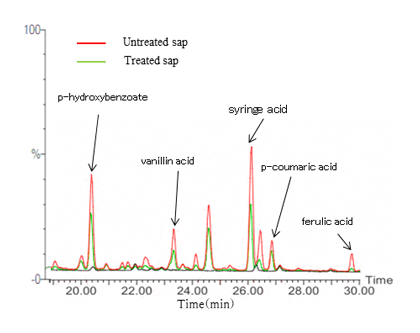pH adjustment of oil palm sap improves lactic acid fermentation
Description
Oil palm sap (OPS) holds great promise as a naturally derived nutrient medium for microbes because it contains large amounts of amino acids, minerals, and free sugars. We have shown the usefulness of OPS as nutrient medium when we investigated ethanol production by fermentation using yeast. However, declining fermentation ability and delayed fermentation were observed during lactic acid fermentation. Lactic acid fermentation is very important in beverage applications and organic acid production, hence it is necessary to develop an improved method (of using OPS) that can also be applied for general purposes. We have developed a simple method to adjust the pH of OPS to remove fermentation inhibitors and revive lactic fermentation ability.
Lactic acid fermentation was obstructed by an ingredient of OPS, and the conversion efficiency of sugar was only about half of the theoretical yield (Table 1). When the pH of OPS was raised progressively, insoluble sediments were formed in weak alkali (Fig. 1). The insoluble sediments were removed and the pH of OPS returned to near neutral. Lactic acid fermentation ability was restored when treated OPS was used for lactic fermentation. In particular, when lactic acid fermentation using the treated OPS (which had been adjusted to alkaline pH 9.0) was performed, the lactic acid amount, the conversion rate, and productivity improved by 1.5-3 times in comparison with lactic acid fermentation that used untreated OPS (Table 1). Fermentation inhibitors such as aromatic compounds contained in plant raw materials have been thought to inhibit the growth of lactic acid bacteria. Identification of aromatic compounds in the treated and untreated OPS was performed by gas chromatography mass spectrometry, and it was found that aromatic compounds such as p-hydroxybenzoate, vanillin acid, syringe acid, p-coumaric acid, and ferulic acid greatly decreased in the treated OPS (Fig. 2).
Figure, table
-
Table 1. Lactic acid production from oil palm sap pretreated using acidic and alkaline precipitation by Bacillus coagulans strain 191
-
Fig. 1. Treatment of sap at various pH
-
Fig. 2. Identification of aromatic compounds in the treated and untreated sap
- Affiliation
-
Japan International Research Center for Agricultural Sciences Biological Resources and Post-harvest Division
- Research project
- Program name
- Term of research
-
FY2017(2011~2020)
- Responsible researcher
-
Arai Takamitsu ( Biological Resources and Post-harvest Division )
MIERUKA ID: 001768Kosugi Akihiko ( Biological Resources and Post-harvest Division )
Balakrishnan Kunasundari ( Universiti Sains Malaysia )
Kumar Sudesh ( Universiti Sains Malaysia )
- ほか
- Publication, etc.
-
https://doi.org/10.1007/s12010-017-2454-z
Kunasundari B et al. (2017) Appl. Biochem. Biotechnol, 183:412-425
Akihiko Kosugi, Takaaki Araki. A process for the preparation of sap. Patent: JP6238416
- Japanese PDF
-
A4 274.47 KB
A3 273.47 KB
- English PDF
-
A4 252.28 KB
A3 235.74 KB
- Poster PDF
-
2017_C02_poster.pdf404.52 KB



